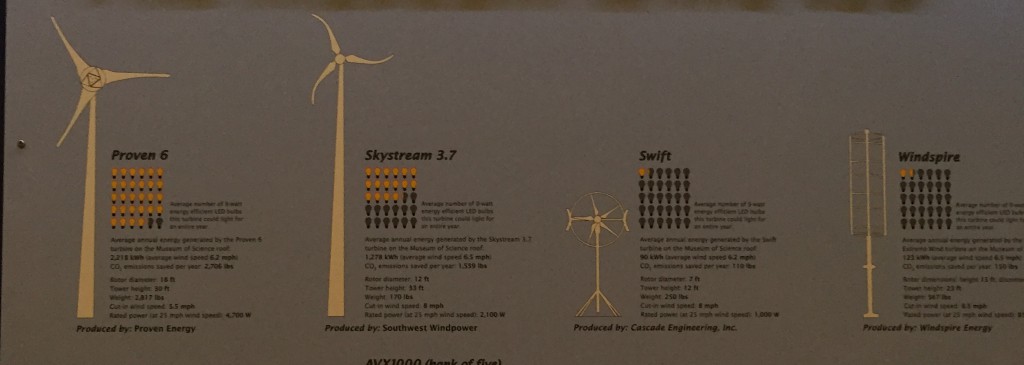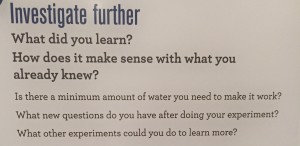Introduction
We went on a trip to the Museum of Science in Boston, and were asked to review four exhibits: Energized!, Catching the Wind, Conserve@Home, and Investigate. Energized! focused on different ways of generating energy. Catching the Wind focused on wind turbine energy. Conserve@Home showed different ways of recycling and conserving energy. Investigate! provided opportunities for observation and experimentation. I will review my reaction to these exhibits here.
Energized! Exhibit
 In the Energized! Exhibit, one part of the exhibit showed how energy levels generated by solar energy change throughout the
In the Energized! Exhibit, one part of the exhibit showed how energy levels generated by solar energy change throughout the
day, depending on the time of day. This is similar to an experiment we did in class in looking at how much solar energy was generated when we directed light from a flashlight on a solar cell.
To the left, you can see the picture I took of this part of the exhibit. Notice the arrows labeled “Morning”, “Noon”, and “Afternoon”. These are associated with three buttons on the console. As you can see, I pushed the button on the right, and that directed Afternoon levels of light at the solar panel (see the red wand). A display is made that shows the level of energy being generated – see the red box on the left.
Observe that the black surface on which the light is falling is irregularly shaped, like a building would be. This is to demonstrate that not only does the surface matter, but the location of the light source matters, in terms of generating solar energy.
Catching the Wind Exhibit
This exhibit focused on wind energy. There was a tube under which a person can place their hand and feel wind. This is the amount of wind needed in order to turn a wind turbine. I tried it, and it was not a very strong wind, but it was definitely stronger than a breeze.
They had a display that showed several different types of wind turbines.

This picture shows four different turbines. I had not really thought about the differences between these before this exhibit. One way they demonstrate the differences is by showing how many light bulbs could be lit for a year using the energy from this turbine. They show this with a graphic to the right of the turbine.
As you can see by the graphics, the one on the left produces the most energy. This can be seen by all the yellow light bulbs that would be lit for a year. The turbine to the right of it is similar, but the ones on the far right seem far less productive.
Conserve@Home Exhibit
There were two sections of this exhibit I will talk about: A part that showed how waste can be recycled into products, and a
part that showed, how “smart” houses might be able to generate energy from within themselves.
What a Waste! Display
 On the left, you will see a picture I took of the first part I mentioned. The flaps over the wooden boxes show an example of a type of waste. When you lift the flap, inside is an example of a product that can be made through this type of waste As you can see on the right, a person is lifting the flap and showing a type of garment that can be made out of recycled materials. The point of this part of the display was to show how different household waste we see every day could be changed into something new that we need at home.
On the left, you will see a picture I took of the first part I mentioned. The flaps over the wooden boxes show an example of a type of waste. When you lift the flap, inside is an example of a product that can be made through this type of waste As you can see on the right, a person is lifting the flap and showing a type of garment that can be made out of recycled materials. The point of this part of the display was to show how different household waste we see every day could be changed into something new that we need at home.
Turn Your Energy Into Light Display
 In this display, there was a steering wheel (lower right). As I turned the steering wheel, it would generate electricity that
In this display, there was a steering wheel (lower right). As I turned the steering wheel, it would generate electricity that
would be shown by how much the lights connected to the steering wheel lit up. If I turned the wheel very fast, it generated more energy.
There were three kinds of lights: The one of the left is LED, the one in the middle is incandescent, and the last one was CFL (fluorescent). I noticed that as I turned the wheel, there was a delay between that and the lights coming on. And, I noticed this delay was the shortest with the incandescent light – it came right on when I started turning the wheel.
Investigate Exhibit
 Finally, the Investigate exhibit encouraged us to consider some ideas from a scientific perspective. I was very interested in a particular exhibit that showed how a toilet flushed. I took a video of this, but I had trouble posting it, so I will post the picture here. Notice that in the toilet bowl, there are two white floating ping pong balls. When it is flushed, we can see the balls travel to the left through the pipes.
Finally, the Investigate exhibit encouraged us to consider some ideas from a scientific perspective. I was very interested in a particular exhibit that showed how a toilet flushed. I took a video of this, but I had trouble posting it, so I will post the picture here. Notice that in the toilet bowl, there are two white floating ping pong balls. When it is flushed, we can see the balls travel to the left through the pipes.
Notice the white vertical pipe on the back wall. The balls actually travel through the plumbing system and end up coming down that pipe! After viewing this, these questions were posted to think about:
 To answer some of these questions, I learned the process of how the mechanisms in a toilet work to push the water along, since it was transparent. It made sense now with the sound I would hear with the flush; I now can see what happens along with the sound. Also, I was able to see how narrow this was, and I totally understand why people are told not to put too much paper in the toilet! It is easy to plug.
To answer some of these questions, I learned the process of how the mechanisms in a toilet work to push the water along, since it was transparent. It made sense now with the sound I would hear with the flush; I now can see what happens along with the sound. Also, I was able to see how narrow this was, and I totally understand why people are told not to put too much paper in the toilet! It is easy to plug.
Conclusion
In conclusion, I enjoyed looking at these different exhibits. From the Energize! exhibit, I was able to see the effect of the sun moving across the sky on solar energy generation. In the Catching the Wind exhibit, I learned about the different types of wind turbines and how much energy they make. In the What a Waste! display, I learned about a lot of products that can be made from recycled waste. And finally, in the Investigate exhibit, I learned about how the water in a toilet flows.